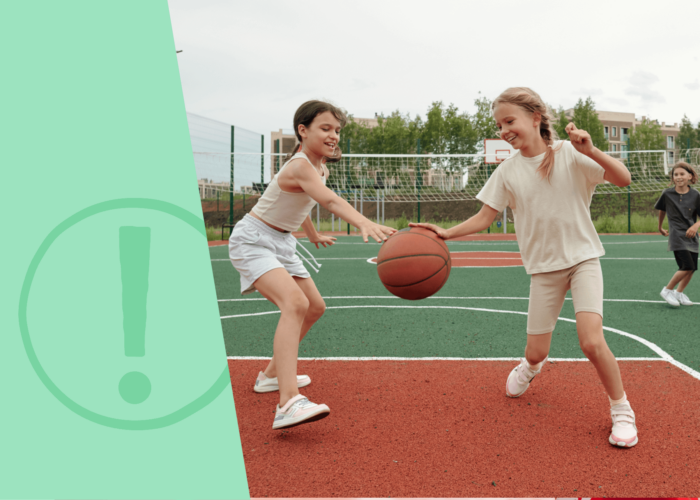The number 1 reason why primary-aged girls don’t enjoy PE

The number 1 reason why primary-aged girls don’t enjoy PE and how to overcome this obstacle
The recent 2023 Girls Active report by The Youth Sports Trust has revealed that the number 1 reason, given by school-aged girls, for not enjoying PE was “I don’t like getting hot and sweaty.”
As teachers, it could be easy to think, well there’s not an awful lot we can do about that, as sweating is often a reality of carrying out a productive session; however, there are a number of useful strategies related to both our time management and controlling the environment, that will help our groups to enjoy PE more without it impacting the rest of the day.
Time management
Time management is a crucial part of any successful lesson, not only because it helps us to achieve our activity objectives, but when done right, we give our groups plenty of time to cool down and get ready for their next class.
Plan Ahead: Select your lesson plans and build a curriculum map ahead of time to outline the activities and goals for each class. This will help you stay organised and ensure that you cover all the necessary content.
Set Clear Objectives: Clearly communicate the learning objectives to your students at the beginning of each class. This will help them understand the purpose of the lesson and stay focused.
Use Timers and Alarms: This helps to signal the start and end of different activities or segments of your class. This can help you stick to the schedule and keep the class moving smoothly.
Minimise Transitions: Reduce the time spent on transitioning between activities. Have a plan for smoothly moving from one exercise to the next without long breaks.
Organise Equipment: Have all the necessary equipment and materials ready and organised before the class starts. This reduces the time spent searching for items during the lesson.
Delegate Responsibilities: If possible, delegate some responsibilities to pupils, such as setting up and putting away equipment. This can help save time and teach pupils responsibility.
Incorporate Technology: Use technology, like The PE Hub platform, to assist in managing tasks, schedules, and pupil information. Streamlining administrative work and allowing you to move quickly into the activities.
Manage Behaviour Effectively: Develop a classroom management strategy that helps maintain discipline and order, allowing more time for teaching and less time dealing with disruptions.
Reflect and Adapt: After each class, reflect on what went well and what could be improved in terms of time management. Make adjustments as needed to optimise future lessons.
Be Responsive: It can be frustrating when you have a session planned out, and the children arrive late or take too long getting ready, but you should not compound the problem by overrunning, especially if they have another class to get to. Reduce your timings and allow the children plenty of time to cool down and get changed so they don’t feel rushed and anxious, then associate this feeling with PE.
Controlling the Environment
Sometimes, getting hot and sweaty is unavoidable when taking part in an active PE session; however, there are several ways in which we can minimise overheating, allowing children to feel more comfortable and get the most out of the lesson without affecting the rest of the day!
Proper Attire: Ensure that students have access to appropriate sports attire, including breathable and moisture-wicking fabrics. This will help them stay cooler and more comfortable during physical activities.
Hydration: Emphasise the importance of staying hydrated, encouraging students to drink water before, during, and after the class. Provide water breaks when necessary to prevent overheating.
Adjust Activity Intensity: Modify activities to suit different fitness levels and preferences. Offer a variety of activities that allow students to choose the level of intensity that they are comfortable with.
Cooling Off Periods: Integrate short cooling off periods into the class where students can rest and lower their body temperature. You can use these periods for teaching related concepts or having brief discussions.
Educate about Benefits: Explain the benefits of getting hot and sweaty during physical activity. Let students know that sweating is a natural and healthy response to exercise, and it helps the body regulate temperature and remove toxins.
Positive Environment: Create a positive and inclusive class environment where students feel comfortable and supported, regardless of their fitness level or how much they sweat.
Fun and Games: Incorporate games and fun challenges into the curriculum to make PE more enjoyable. When children are having fun, they may be more willing to overlook the discomfort of getting sweaty.
Open Communication: Encourage pupils to communicate their concerns and discomfort. If they feel safe expressing their feelings, you can work together to find solutions.
Ventilation: If you teach in an indoor facility, ensure proper ventilation and air conditioning if available.
Peer Support: Encourage students to support each other and create a positive peer culture in the class. This can help alleviate self-consciousness and anxiety.
Implementing these strategies might just be the reason why a young person starts to enjoy PE more. So try them out, and let’s be difference makers #GirlsActive

